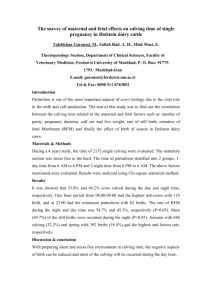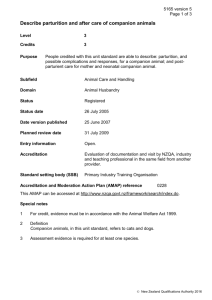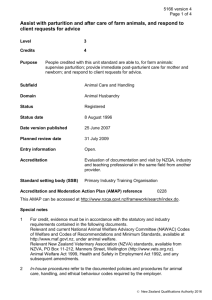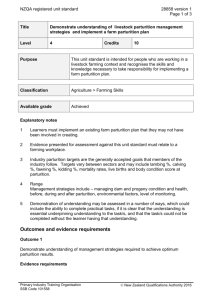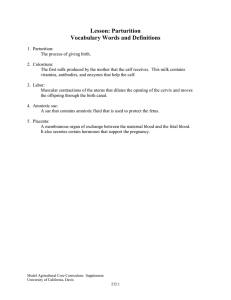CLF232
advertisement
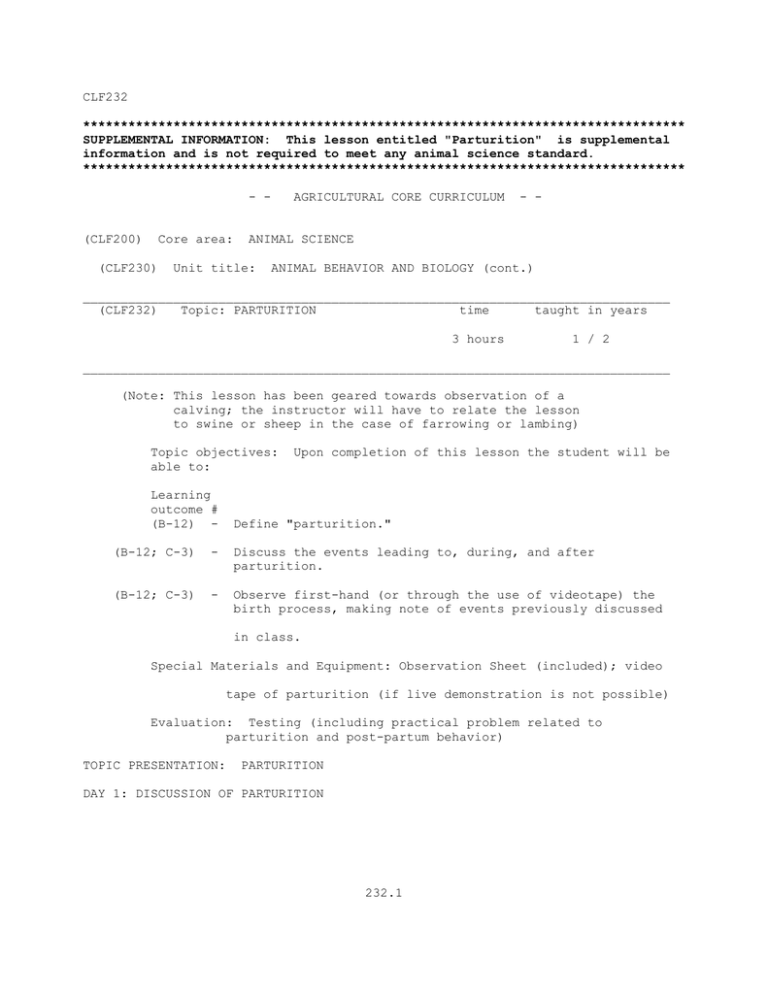
CLF232 ******************************************************************************** SUPPLEMENTAL INFORMATION: This lesson entitled "Parturition" is supplemental information and is not required to meet any animal science standard. ******************************************************************************** - (CLF200) Core area: (CLF230) AGRICULTURAL CORE CURRICULUM - - ANIMAL SCIENCE Unit title: ANIMAL BEHAVIOR AND BIOLOGY (cont.) ______________________________________________________________________________ (CLF232) Topic: PARTURITION time taught in years 3 hours 1 / 2 ______________________________________________________________________________ (Note: This lesson has been geared towards observation of a calving; the instructor will have to relate the lesson to swine or sheep in the case of farrowing or lambing) Topic objectives: able to: Learning outcome # (B-12) - Upon completion of this lesson the student will be Define "parturition." (B-12; C-3) - Discuss the events leading to, during, and after parturition. (B-12; C-3) - Observe first-hand (or through the use of videotape) the birth process, making note of events previously discussed in class. Special Materials and Equipment: Observation Sheet (included); video tape of parturition (if live demonstration is not possible) Evaluation: Testing (including practical problem related to parturition and post-partum behavior) TOPIC PRESENTATION: PARTURITION DAY 1: DISCUSSION OF PARTURITION 232.1 ________________________________________________ ACTIVITY: As students come in have the word PARTURITION written on the chalkboard; ask the students to write down on slips of paper what they think the word means; collect the slips and read the definitions to the class (without reading names of course), pointing out the correct definition if you find it; let the students know that over the next three days they will be discussing and observing an animal birth. _________________________________________________ I. Parturition A. What is it? 1. "the act or process of giving birth" II. Signs of Approaching Parturition A. Distended (swollen) udder B. As parturition approaches fluid contents of udder change from a watery solution to the thick, milky colostrum. C. Muscles in the rear of the cow begin to shrink or fall away. D. There is a noticeable enlargement and swelling of the vulva. E. Cow becomes extremely nervous and uneasy. F. Muscular contractions are evident as labor begins. III. Parturition--Normal Presentation (See enrichment below: VI Parturition--Abnormal Presentation. See also reference: Ensminger, "Dairy Cattle Science") A. Mild labor pains usually start several hours before actual parturition. B. The first water bag will appear on the outside, increasing in size until it ruptures due to its own weight. C. Immediately after the first water bag, the amniotic bladder (the second water bag) follows, containing the fetus. D. When the second water bag ruptures, straining on the cow's part becomes more pronounced and presentation (actually seeing the fetus) soon follows. E. The most common presentation is: (see Ensminger, Dairy Cattle Science, 1981) 232.2 1. front feet first, followed by nose which is resting on them. 2. shoulders 3. middle 4. hips 5. hind legs and feet IV. Newborn Calves A. A vigorous calf will attempt to stand in about 15 minutes and usually will be nursing within about 30 to 60 minutes. B. The weaker the calf, the longer it takes for it to begin nursing. 1. Human assistance is sometimes necessary to get a calf to begin nursing (Be sure to restrain the dam before bringing the calf to her.) V. The Afterbirth A. Three to six hours after parturition the placenta (commonly called afterbirth) is expelled. B. If the placenta remains in the cow for more than 24 hours, it must be removed manually. 1. An experienced caretaker or licensed veterenarian should take charge of removal, since if improperly done the cow may be rendered incapable of being rebred. VI. Enrichment (will take more time than allowed for in lesson): Parturition--Abnormal Presentation (see Ensminger, "Dairy Cattle Science," 1981, pp. 80-81.) A. If presentation is normal and within 1-2 hours after the first signs of calving, then no assistance is necessary. B. If the cow has been laboring for some time without any progress, or is laboring infrequently, it is usually necessary to lend assistance to her (go over handout on abnormal presentations). 1. With posterior presentations (hind feet first), there is likely to be calving difficulty, including an increased danger of suffocation due to umbilical cord rupture or strangulation. C. Assistance usually consists of fastening small ropes or chains around the pasterns and pulling the calf outward and downward as the cow strains. THIS SHOULD BE DONE ONLY BY AN EXPERIENCED HERDSMAN OR A COMPETENT VETERINARIAN. 232.3 D. Remember that rough, careless, or unsanitary methods during this time can cause serious problems for the cow and calf, including death of the offspring and dam.. DAY 2: OBSERVATION OF PARTURITION ______________________________________________________________ ACTIVITY: Arrangements should have already been made with a local rancher, dairyman, etc. to observe a calving. Remind students that in order to best observe a natural behavior it is important they remain as quiet and inconspicuous as possible. Observation forms (see Appendix 1) should also be collected at the end of the day in order to assure that all students have participated in the observation. Forms can be returned the following day prior to class discussion. Note: If using a videotape, students should still use the observation sheet; the instructor may want to stop the tape periodically to discuss what is occurring with the class. Introduction: Before leaving on the field trip, remind students of the kind of the events they may observe. Students should also be told to write down as much detail as possible about what they observe. This will make the birth process clearer to them when they discuss those observations tomorrow. If the instructor feels it would be more effective, she/he may break the class into small "observation units". Each unit then works as a team. ______________________________________________________________ ______________________________________________________________ ACTIVITY (Alternate): Adopt a pregnant animal (ewe, sow, rabbit, etc.) as a class project. Have the students maintain the animal, keep records of food consumption, weight gain, etc. and assist in birth (use the observation form) and post-natal care. ______________________________________________________________ OBSERVATION FORM IS ATTACHED DAY 3: DISCUSSION OF OBSERVATIONS MADE YESTERDAY 232.4 ______________________________________________________________ ACTIVITY: Introduction: Break class into groups (or if you used groups yesterday, have them get back into those groups) and give them a few minutes to review their notes (the fact that you collected them also ensures that no one "left theirs at home") before the discussion. C. Class Discussion of Observations C. Take each group and have them report any observations made, relating that observation to the information they received in class two days ago. B. Note any special conditions present during the observation and discuss how those conditions may have affected the birth process. C. Summarize, on the board or overhead, what the students observed while on the field trip. ______________________________________________________________ 232.5 Observation Form (Parturition) Return to Your Instructor After Completion Name of Individual(s) Making Observation:_____________________________________ ______________________________________________________________________________ Date of Observation:____________________ Time of Day:_________________________ Location of Observation:______________________________________________________ Species and Breed of Animal Observed:_________________________________________ ______________________________________________________________________________ Special Conditions (unusual location, extreme weather conditions, etc.): ______________________________________________________________________________ Observations made (be as detailed as possible, even if it seems "silly" or "stupid"): ______________________________________________________________________________ ______________________________________________________________________________ ______________________________________________________________________________ ______________________________________________________________________________ ______________________________________________________________________________ ______________________________________________________________________________ ______________________________________________________________________________ ______________________________________________________________________________ ______________________________________________________________________________ ______________________________________________________________________________ ______________________________________________________________________________ (Use back of worksheet if additional space is needed) 232.6
